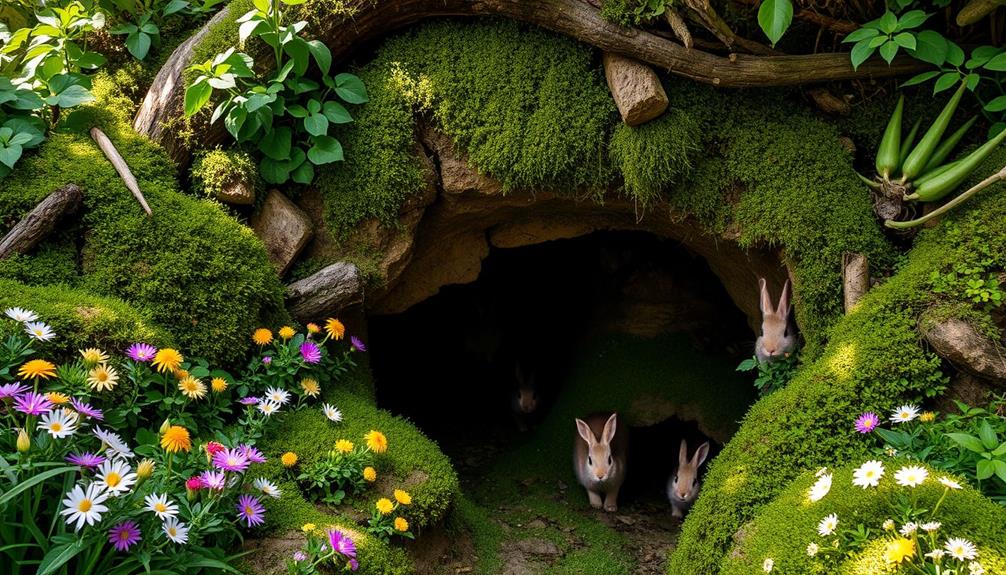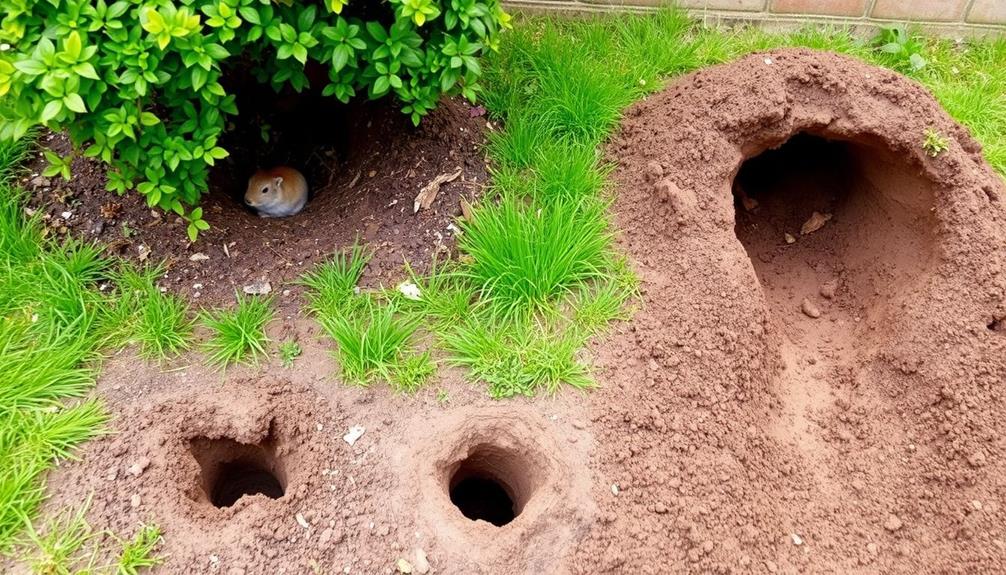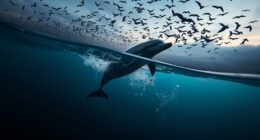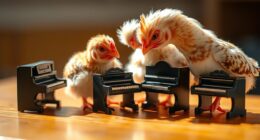Dolphins live in complex social structures, forming pods of 40 to 60 individuals that display intricate ties and dynamics. They communicate through unique whistles and body language, showcasing their emotional depth. Personalities influence interactions, while strong mother-calf bonds play an essential role in social development. Their fission-fusion society encourages genetic diversity and social learning, creating a vibrant community. Discovering more about their behavior and social dynamics reveals fascinating insights into dolphin lives.
Key Takeaways
- Dolphins live in pods of 40 to 60 individuals, exhibiting complex social structures shaped by personal relationships and hierarchies.
- They communicate through unique vocalizations, including signature whistles, and body language, enhancing social bonds and group coordination.
- Individual personalities influence interactions, with bolder dolphins often leading information sharing and social dynamics within the pod.
- The mother-calf bond is the strongest in dolphin communities, essential for emotional development and social learning during early years.
- Conservation efforts benefit from understanding dolphin social dynamics and emotional depth, which are crucial for the species' well-being.
Complex Social Structures of Dolphin Pods

When you plunge into the world of dolphin pods, you'll quickly discover that their social structures are anything but simple. Typical pods consist of 40 to 60 individuals, yet they can vary dramatically in size.
Within these pods, social dynamics are shaped by individual personalities and relationships. Adult males often establish hierarchies, influencing their behaviors and reproductive success.
Dolphins exhibit fission-fusion dynamics, allowing them to switch groups while maintaining strong bonds, much like human friendships. The coefficient of association helps measure these connections, with values closer to 1 indicating stronger social ties.
Signature whistles serve as unique identifiers, reinforcing these relationships, as dolphins navigate their complex social landscape, showcasing a rich tapestry of interactions that echo our own social lives.
Communication Methods in Dolphins

Dolphins have a fascinating way of communicating that goes beyond simple sounds.
They use a mix of vocalizations, like clicks and whistles, along with body language signals to express themselves and strengthen their social bonds.
Vocalizations and Whistles
The fascinating world of dolphin communication reveals a complex system of vocalizations that includes clicks, whistles, and even body movements.
As social animals, dolphins rely on these sounds to interact and coordinate with one another within their pods. Each dolphin possesses a unique signature whistle, acting like a name that allows them to identify and call each other over long distances.
You might find it intriguing that dolphins engage in whistle matching, mimicking the signature whistles of their companions to strengthen social bonds.
Their ability to produce various whistles with different frequencies and durations enables them to share specific information about their surroundings and social dynamics.
This advanced communication is essential for cooperative behaviors, such as hunting and steering through complex relationships.
Body Language Signals
Although vocalizations are essential for dolphin communication, body language plays an equally important role in conveying emotions and intentions.
Dolphins use a variety of body language signals, such as postures, movements, and facial expressions, to interact with one another within their pods. For instance, breaching can indicate excitement, while tail slaps serve as warning signals to alert companions of danger.
Synchronized swimming not only strengthens social bonds but also enhances group coordination, illustrating the importance of social learning in dolphins' social lives.
You'll notice playful head nods and rolling behaviors that suggest readiness for cooperative activities, like hunting. By observing these body language signals, you can gain deeper insight into the complex social dynamics of dolphins.
The Role of Personalities in Social Dynamics

When you observe dolphin pods, you'll notice that individual personalities play a vital role in shaping their social dynamics.
Bolder dolphins often emerge as leaders, influencing interactions and communication within the group.
This unique blend of traits not only affects friendships but also impacts mating and overall group cohesion.
Individual Traits Influence Interactions
Individual personality traits greatly shape how dolphins interact within their pods, influencing everything from cooperation to communication. In bottlenose dolphins, these traits create a dynamic social environment where relationships are defined not just by kinship but by individual characteristics.
- Bolder dolphins often assume central roles, driving information sharing.
- Responses to new stimuli vary greatly, showcasing adaptability linked to personality.
- The strength of social bonds can be measured through the coefficient of association, reflecting the impact of individual personality traits.
These nuances in dolphin social behavior highlight how personal traits contribute to the intricate web of interactions within pods, ultimately affecting their overall social dynamics.
Understanding these influences is vital for appreciating the complexity of dolphin societies.
Boldness and Social Roles
Boldness plays an essential role in shaping social dynamics within dolphin pods, as those who exhibit more daring traits often take on central roles that facilitate communication and cooperation. Bolder dolphins create alliances, fostering stronger bonds and enhancing group cohesion. Their attraction to novelty drives adaptive behaviors, allowing them to respond effectively to new stimuli.
| Bold Dolphins | Social Impact |
|---|---|
| Form strong alliances | Enhance communication |
| Lead cooperative hunts | Foster group cohesion |
| Attract similar personalities | Promote friendship |
| Influence group dynamics | guarantee successful interactions |
In this way, boldness not only defines individual roles but also shapes the very essence of dolphin society, illustrating the profound impact of personality on social structures.
Fission-Fusion Societies and Lifelong Bonds

Dolphins thrive in dynamic social environments where fission-fusion societies allow them to fluidly shift between groups while forming strong connections with chosen companions.
You'll notice that these social dynamics create a rich tapestry of relationships, highlighting the significance of lifelong bonds.
- Individual dolphins maintain preferred associates, resembling human friendships.
- Male alliances often form, showcasing cooperation that aids in hunting and protection.
- Fission-fusion dynamics enable dolphins to enhance genetic diversity and social learning through varied interactions.
These bonds aren't just fleeting; they reflect emotional depth, as dolphins nurture connections even when circumstances change.
Understanding these intricate social structures is essential for grasping their behavior and ecology, revealing how communication and cooperation flourish among pods.
Benefits and Challenges of Group Living

While living in groups offers dolphins numerous advantages, it also presents unique challenges that can impact their social dynamics.
Social dolphins benefit from enhanced survival strategies through cooperation in hunting and predator evasion. However, larger groups of dolphins can lead to fierce competition for resources, which may increase aggression and complicate mating dynamics.
For instance, research on a pod from Little Bahama Bank showed that after a hurricane, population loss forced dolphins to adjust their social structures over time.
These marine mammals form intricate relationships that greatly influence their survival and reproductive success. Therefore, while group living fosters camaraderie, it also introduces complexities that can affect the overall harmony within the pod.
Cultural Behaviors and Learning in Dolphins

Group living not only influences social dynamics but also plays a significant role in shaping cultural behaviors among dolphins. These intelligent creatures rely on social learning to pass unique foraging techniques from mother to calf, particularly evident in populations like Shark Bay.
- Dolphins mimic each other's whistles, enhancing communication and social bonds within pods.
- Research shows 87% of calves adopt their mother's foraging strategies, showcasing the impact of social learning.
- Cultural behaviors can be transmitted across generations, highlighting the importance of observation and imitation.
While evidence of culture exists in dolphin populations, ongoing research is essential to fully understand the mechanisms behind behavior transmission and the ecological factors that influence these cultural traits.
The Mother-Calf Bond and Social Development

As a dolphin calf grows, the bond with its mother becomes essential for survival and social development. This mother-calf bond is one of the strongest social connections in the ocean, as mothers provide nourishment and critical lessons in social learning during the early years.
Even as juvenile dolphins, calves continue to rely on their mothers, who teach them important social skills. The emotional connections between them deepen through nurturing behaviors and activities like synchronized swimming.
While this bond may weaken with the arrival of new calves, it can remain strong if no new calf is born. The profound grief displayed by mothers carrying deceased calves further illustrates the emotional depth of these relationships, highlighting their significance in dolphin society.
Conservation Efforts for Dolphin Populations

The strong bonds formed between mother dolphins and their calves highlight the importance of social structures in dolphin communities, which plays a significant role in conservation efforts.
Understanding these dynamics is essential for protecting wild dolphins effectively. Here are key aspects of ongoing conservation initiatives:
- Research on dolphin behavior helps inform policies that enhance social dolphin interactions.
- Collaborative studies among scientists develop strategies to meet both ecological and social needs of dolphin populations.
- Public involvement, like reporting strandings and supporting initiatives, strengthens conservation efforts.
Frequently Asked Questions
What Is a Dolphin's Social Life?
A dolphin's social life is dynamic and complex.
You're likely to find them in pods, where they form strong bonds with each other, often helping in hunting and avoiding predators. Their relationships are fluid, allowing them to switch groups while maintaining lifelong connections.
You'll see individual personalities influencing roles, with bolder dolphins often leading interactions.
These social creatures even exhibit emotions, showing grief when they lose a pod member, highlighting their deep emotional ties.
What Is the Social Interaction of Dolphins?
Imagine a bustling underwater city where dolphins dance through the waves, communicating with clicks and whistles that echo like laughter.
In this vibrant world, you'll see dolphins engaging in playful games, forming tight-knit pods that act as family units. Their interactions are filled with physical affection, like gentle nuzzles and synchronized swimming, strengthening bonds.
You'll witness their emotional depth, as they comfort each other during tough times, showcasing a rich tapestry of social interaction.
How Do Dolphin Societies Look Like?
Dolphin societies are fascinating, structured around pods that can vary in size, usually averaging 40 to 60 members.
You'll notice these groups foster cooperation, helping dolphins hunt and protect each other from predators.
Each pod has its own social hierarchy, influenced by individual personalities.
Dolphins maintain strong bonds, often shifting between pods while nurturing deep connections with certain members, showcasing emotional ties that enhance their survival and reproductive success.
How Do Dolphins Live in Groups?
Imagine a vibrant tapestry, woven with threads of connection and individuality.
Dolphins live in groups called pods, where each member plays a unique role, much like colors in that tapestry. You'll find them teaming up for hunting or evading predators, showcasing their strong social bonds.
These pods can shift dynamically, allowing dolphins to maintain lifelong friendships while adapting to their environment. Ultimately, their social structures mirror human relationships, rich with complexity and depth.
Conclusion
In the intricate tapestry of dolphin social lives, each thread represents a unique bond, woven together by communication, personalities, and shared experiences. These intelligent creatures navigate the complexities of their pods with grace, forming lifelong connections that are as essential as the ocean itself. As we work to protect their habitats, we're not just safeguarding a species; we're preserving the vibrant communities that thrive beneath the waves. Let's guarantee these social networks continue to flourish for generations to come.










